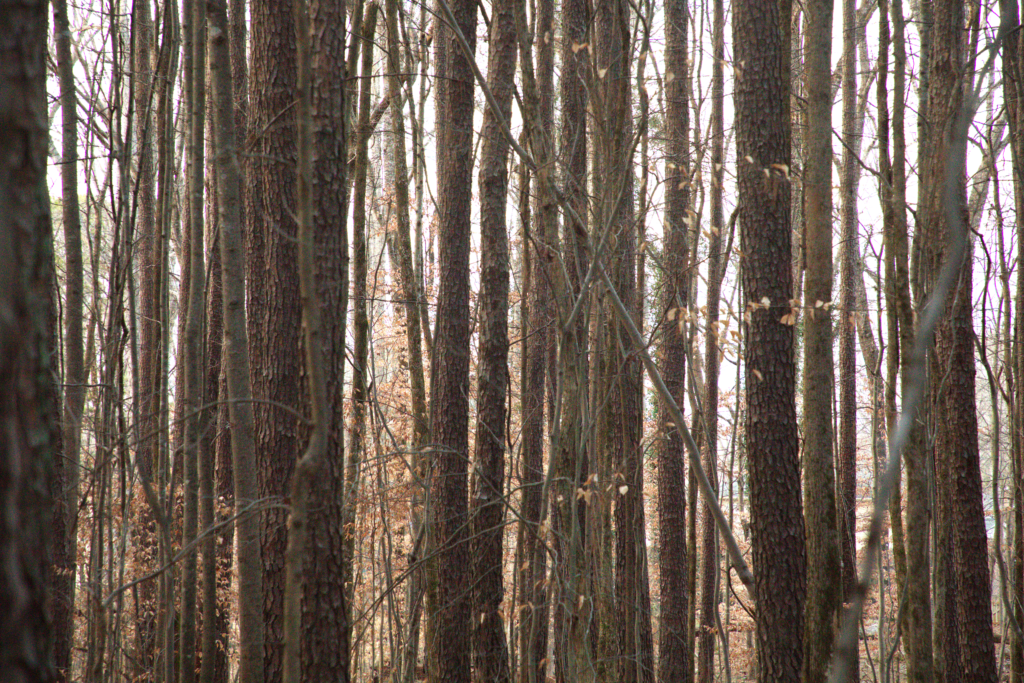Journal entry from 2/3/2021
For context–I admittedly did not know how to post on the wordpress site until this weekend and have been recording all my entries in a google doc. This was my first entry from early February.

According to the stories you invariably end up hearing in small town bowling alleys in the midwest, turn-of-the-century loggers in the northern pine stands of Wisconsin and the Upper Peninsula of Michigan would refuse to sleep in a logging camp if any of its buildings had even a single stick of wood that wasn’t White Pine. I can empathize with that feeling even though my reasons are far less soaked in sweat and sap than those loggers. I have found that the most beautiful forests I have walked in have been White Pine forests. There is one stand in particular, near to where I last engaged in a habitation journal-style activity (I called it a phenology journal then) where the White Pines were never logged and exist as they were before nearly all the midwest was clear cut. My favorite spot lies two miles across the Michigan-Wisconsin border in the Sylvania Wilderness Area. There, the White Pines give way to Hemlocks on the banks of Loon Lake, whose waters are near black from the tannins leached by Hemlock needles. If you were to scoop up the water in a clear bottle, it would look like a strong cup of English breakfast tea.
I think that each pine forest has a defining uniqueness to it in a way other forests don’t. I love the Beeches, Oaks, Maples, and Elms that populate the Shenandoah greenscapes I am most familiar with. They are lovely in their standardness. I know those forests, and I know that I can find similar forests with similar feelings about them in Western Maryland, or Pennsylvania, or North Carolina.
But the pine stands are not so easily typecast. In Wisconsin and Michigan the character of those stands was a wonderfully mischievous wildness that felt much larger and more acute in its natural power than most other places. The first time I saw the deeply dark water of Loon Lake I thought of Sauramons tower in the Lord of the Rings: obviously dangerous, obviously powerful, but so, so beautiful.
The pine stand in the Guilford woods possesses a similarly powerful character too, I think. I have felt that it boasts a quietness I’ve been unable to find anywhere else on campus, or in Greensboro at all, for that matter. For me, that quietness comes most directly from the ground. If you walk into the pine stand in the woods from a more deciduous area, you’ll notice a change underfoot. The ground–usually ruddy or muddy or rooty or rocky–changes to an enclosed softness. The first steps yield a sharp crunching feel, and you’ll almost unconsciously begin to walk more tenderly. A few paces in and you begin to get a sense for the point at which the needles break and give way to a softer depression. The ground is truly different in its composition. The rest of the woods offer bare soil, or soil under a thin layer of leaves and twigs. Under the Loblolly, though, there’s a good inch of gently browned needles and another two of humus before reaching dirt.
The relative remoteness of the Loblolly stand adds to the quietness, too. Without a guide, the stand would be hard to find without prior knowledge of the woods. The main loop that the lake and North apartment entrances to the woods lead to does not directly connect to the pines. The lack of signage doesn’t help either, nor does the fact that the Loblolly make up just 10 of the woods 240 acres. While I consistently see joggers or dog walkers in the better-traveled sections of the woods, I rarely see more than one other person in the Loblolly. Perhaps this is because there are none of the usual landmarks that draw students to certain sections of the woods. There are no fire pits, no forts and no streams or ponds. Even the deer tend to just pass through the Loblolly on their way to someplace else. There is minimal ground cover due to the acidic humus and few young trees, leaving little for them to snack on.
I love this quietness, and I love that it is confined to just a small corner of a small forest. The Loblolly, all of which were planted with the intent of harvest, would’ve never formed such a concentrated community in such a small area on their own. This stand is unnatural and it is individual and its uniqueness has lent it a distinct character.
In some regards, the White Pine stand in the Upper Peninsula that I love and the Loblolly pine stand in the Guilford woods that I love could not be more different. One is old-old growth, never logged, never farmed. The other is as new as a mature forest can be. One is midwestern in location and climate, the other distinctly southern. Nonetheless, the two pine stands are tied by a powerful sense of character unique to pine forests.
Recently, I was asked to identify what I look for in a friend for a class icebreaker. I thought about the question, and who I have chosen to surround myself with, and who I have sought to be surrounded by. I have long sought to surround myself with people of conviction, and I want to surround myself with places of conviction, too. At Guilford, the Loblolly stand is a place of conviction.
The Loblolly Stand, pictured above, carves through the rest of the more deciduous forest.